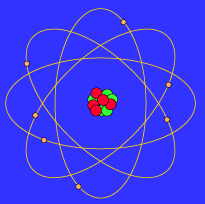The active ingredient in bleach is the hypochlorite (OCl-) ion. This ion is a powerful oxidizing agent which oxidizes many substances under basic conditions. A typical reaction is its behavior with iodide (I-) ions as shown below in net ionic form.
I- (aq) + OCl-(aq) ------> I2 + Cl- + H2O
Balancing redox equations in basic solutions is identical to that of acidic solutions except for the last few steps as shown below.
1. First, divide the equation into two halves; an oxidation half-reaction and reduction-reaction by grouping appropriate species.
2. (ox) I- ----> I2
3.
(red) OCl- ----> Cl- + H2O
4. Second, if needed, balance both equations, by inspection ignoring any oxygen and hydrogen atoms. (The non-hydrogen and non-oxygen atoms are already balanced,hence skip this step)
5. Third, balance the oxygen atoms using water molecules . (The hydrogen and oxygen atoms are already balanced; hence, skip this step also.
6. Fourth, balance any hydrogen atoms by using an (H+) for each hydrogen atom
(ox) 2 I- ----> I2
(as no hydrogens are present, skip this step for this half-reaction)
(red) 2 H+ + OCl- -----> Cl- + H2O
(two hydrogen ions must be added to balance the hydrogens in the water molecule).
7. Fifth, use electrons (e-) to equalize the net charge on both sides of the equation. Note; each electron (e-) represents a charge of (-1).

8. Sixth, equalize the number of electrons lost with the number of electrons gained by multiplying by an appropriate small whole number.
9. (ox) 2 I- ----> I2 + 2e-
(red) 2e- + 2 H+ + OCl- ----> Cl- + H2O
(as the number of electrons lost equals the number of electrons gained, skip this step)
10. Add the two equations, as shown below.
2 e- + 2 I- + 2 H+ + OCl- ----> I2 + Cl- + H2O + 2e-
and subtract "like" terms from both sides of the equation. Subtracting "2e-" from both sides of the equation gives the net equation:

11. To indicate the fact that the reaction takes place in a basic solution, one must now add one (OH-) unit for every (H+) present in the equation. The OH- ions must be added to both sides of the equation as shown below.
2 OH- + 2 I- + 2 H+ + OCl- -----> I2 + Cl- + H2O + 2 OH-
12. Then, on that side of the equation which contains both (OH-) and (H+) ions, combine them to form H2O. Note, combining the 2 OH- with the 2 H+ ions above gives 2 HOH or 2 H2O molecules as written below.
2 H2O + 2 I- + OCl- ----> I2 + Cl- + H2O + 2 OH-
13. Simplify the equation by subtracting out water molecules, to obtain the final, balanced equation.

Note that both the atoms and charges are equal on both sides of the equation, and the presence of hydroxide ions (OH-) indicates that the reaction occurs in basic solution.



No comments:
Post a Comment